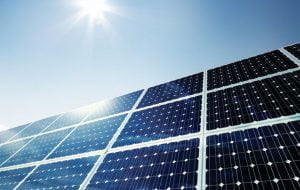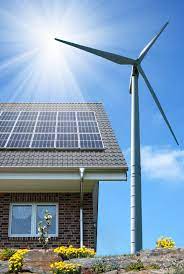Do you want to get off-grid power for your Bangtao or Phuket home, business, small Hotel / Guest house or Restaurant etc using solar panels or wind turbines? Below we’ll explain to you with this handy guide covering all the basics from figuring out your power needs, to understanding 12V and 48V systems, to choosing batteries, power sources and more – everything you need to run your Bangtao Phuket home or business using green Eco-friendly, and mains-free energy.
What is Phuket Solar Power Battery Storage?
Solar panels work by converting the sun’s energy into electricity in order to power your home. It’s very likely that your solar  panels will generate more energy than you can use during the day. If you have solar panels but no solar power battery storage, whatever energy you don’t use is sent back to the National Grid to be used around the country. Solar power battery storage, however, allows you to store any excess solar power you generate to use at times when there is no solar input available.
panels will generate more energy than you can use during the day. If you have solar panels but no solar power battery storage, whatever energy you don’t use is sent back to the National Grid to be used around the country. Solar power battery storage, however, allows you to store any excess solar power you generate to use at times when there is no solar input available.
You may have different solar power storage needs depending on your average daily energy usage. For example, you may use your solar power battery to store energy during times of lower demand (such as the summer time), reducing or even negating the amount you need to buy from your energy supplier when usage is higher. Alternatively, you may only require battery storage for emergency power if your grid supply fails. Either way, storing energy in a solar power battery can save you massive amounts on your energy bill and can help you become more, or even completely, grid independent.
At a glance for you Phuket home or business:
1. Work out how much power you need
2. Familiarize yourself with the equipment required
3. Decide on a power source – Solar or wind, or both
Step 1: Work out how much power you need
Do you just need a couple of lights for occasional use, or do you plan to run your wifi / broadband, mobile chargers, security lights, a computer, TV, air-conditioning, Hotel rooms, or a host of power tools?
The amount of power you require dictates the type of system you install, so calculating your power requirements is key to setting up a system that works for you.
For example, a 5W mobile phone charger will require an inverter with a continuous power rating of at least 150W, whereas a 400W desktop computer would require at least 600W. To work out the power rating of your inverter, simply add up the required wattage of all the equipment you’ll be using. If you need to plug in a computer and mobile phone, the inverter would need a continuous power rating of 150W + 600W = 750W.
Step 2: Familiarize yourself with the equipment
Battery
Once you have captured the energy from the sun or wind, you need to store it for later use by feeding it into a ‘deep cycle battery’ or a ‘deep discharge battery’. The electrical current stored in the battery is usually 12V, 24V) or 48V. It all depends if you want to power a small Phuket office, yatch, shop or restaurant, or a small Hotel / Guesthouse, or your whole home. You can install a bank of more than one battery to increase the available power store.
Inverter
Household items, like computers, blenders, microwave, washing machines, phones etc require a 240V AC power supply. To convert the 12V DC current from your battery bank, you need to route the electricity from the battery through an inverter, which converts the power to AC.
Cables
Installing cables of the correct rating is essential. Overload your circuit and it will overheat and could catch fire; go for too high a rating and you’re just wasting money.
To help you get it right, Solar-Wind provide a handy tool to help you work out which cable rating is right for your needs. If in doubt, contact them directly for advice.
Charge Controller
Positioned between the power source and the battery, a charge controller stops your battery over-charging by regulating the amount of power channeled to it.
Run / Stop switch
Fitted to a wind turbine system, a run / stop switch enables you to temporarily slow down and/or stop the turbine from operating should you wish to, for example, to reposition it.
To simplify the process of powering your Phuket home, there are kits available with all the parts you need included. Midsummer supply a range of kits for solar power, and Wind and sun have some good offerings for wind power. There are plenty of options to choose from out there – the key is to make sure that the kit you buy matches your power needs now and in the future.
Step 3: Decide on a power source
The basic premise behind most solar panel technology is that the panels collect the UV energy from sunlight and transfer it to a battery which charges up with electrical energy to be used later by whatever solar Phuket home light system you have installed. Simple. These panels can be sited either on the ground nearby, or on the Phuket home roof itself.
Pros
A) Panels fitted to a roof can be neat and unobtrusive, unlike the more obvious presence of a wind turbine.
B) Fitting a solar panel to a battery is no more difficult than wiring a plug.
Cons
If your Phuket home is located in a very shady position, then the lack of sunshine even on bright days could limit the amount of electricity generated.
Phuket Wind Turbines
Wind turbines rely on a steady breeze to keep the blades turning, so good positioning is paramount. 
The power in the wind is proportional to the cube of its speed; twice the wind speed gives eight times the power. Small differences in average wind speed cause large differences in available wind energy. So, for optimum performance, it is important to find a site which offers the highest overall wind speeds.
Wind turbines can be roof mounted or pole mounted. While micro roof-mounted wind turbines are cheaper, they’re also less efficient and will produce a lot less electricity than pole-mounted ones. On the other hand, the cable that runs between the power source and the battery is expensive and may limit how far away from your Phuket home you can install a pole mounted turbine.
When the wind blows, it pushes the blades of the turbine and makes them spin. This spinning turns a shaft inside the turbine, which powers a generator, which turns the kinetic energy of the spinning motion into electricity.
Regular wind turbines are usually very tall, and have gigantic blades, to catch as much wind power as possible. Obviously, when you have one in your back garden or roof, you can’t have it built to the same scale, unless you have a lot of land, so you won’t capture nearly as much energy. That’s why domestic Phuket home wind turbines are only recommended for people who live in rural, extra-blustery areas.
Roof-mounted wind turbines
These small wind turbines sit on top of your roof, just like solar panels would. Putting them on the roof gives them the best height to take advantage of the wind blowing over your house.
They’re usually cheaper to install than standalone turbines. But since they’re not as big, they tend to be less powerful, usually generating 1-2kW.
Standalone or pole-mounted wind turbines
Free-standing wind turbines are likely to be more powerful than those that fit on a roof – but only if you put them in the right place. They work best if they’re in a big, open space where there’s nothing to slow down the wind: think in a massive field – or even better, on top of a hill.
Unless you have this kind of land available around your home, a standalone turbine might not work for you. They’re also usually more expensive. But if you do have the space and the money for one, the good news is that you have a better chance of powering your entire house with it than with a roof-mounted system.
What size home wind turbine do I need?
How big a wind turbine you need to power your house will depend, of course, on how much power you use.
The average Phuket home eats 3,731 kWh of electricity per year. A pole-mounted 1.5 KW turbine could deliver around 2,600 kW over the course of a year, depending on the wind speed and other factors. A 10kW system could generate around 10,000 kWh per year.
Remember: these numbers are estimates. To work out whether it makes financial sense for you, you’ll need to know how much energy you actually use, and how much you’re likely to get from the wind speed around your Phuket Villa, house, restaurant, Guesthouse or Hotel.
Check the average wind speed around your Phuket home or business first, and then check how much electric you use per day, month and year. These two checks will tell you if having a wind turbine makes financial logic or not. If not, and you have the roof space go for solar.
So, are domestic wind turbines worth it?
Powering your Phuket home with wind energy is a fantastic way to stay green – but it’s not cheap or easy. Before you take the leap, remember, you need to consider these 5 crucial questions:
Do you have enough space for a wind turbine, either on your land or on your roof?
What’s your local wind speed?
Considering the space and wind speed you have available, will a wind turbine be able to give you as much power as you need?
Have you got enough cash to cover the upfront installation costs?
Do you have planning permission (if you need it)?
Pros
A) Can be a good source of power during the windy, sun-restricted, monsoone season months on Phuket.
B) If your turbine is positioned in the right location on Phuket, a large amount of electricity can be generated quickly.
Cons
A) Correct positioning is very important but is not always easy to achieve, particularly when the cost of the cable limits where you can site your turbine.
B) In the same way that solar-generated electricity is reduced in none windy areas or days. Lighter winds can limit the amount of power available from wind turbines. That’s where solar panels will benefit any Phuket home or Hotel type property on Phuket.
If you can afford it, a combination of both wind turbines and solar power on your Phuket home or business gives you the best of both worlds to being off-grid.
Back to: Eco Friendly Bangtao
